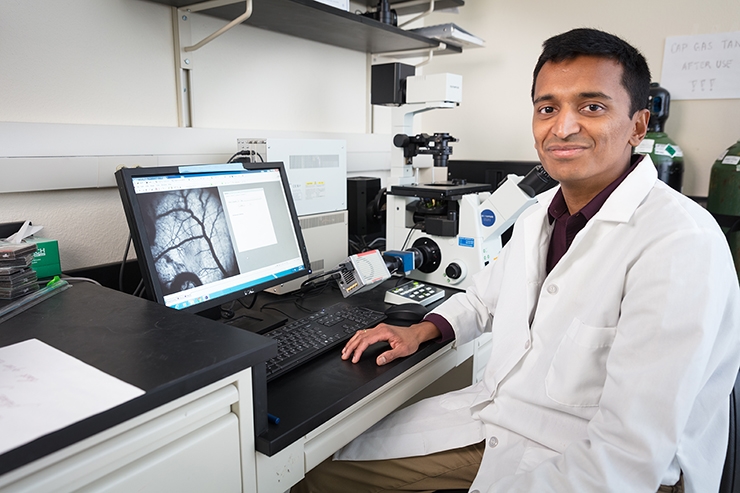
Researchers at the U of A have demonstrated the first use of a noninvasive optical technique to determine complex biochemical changes in cancers treated with immunotherapy.
“We show that optical spectroscopy provides sensitive detection of early changes in the biomolecular composition of tumors,” said Narasimhan Rajaram, associate professor of biomedical engineering. “This is important because these changes predict response to immunotherapy with immune checkpoint inhibitors. Thus, our work is the first step in determining whether Raman spectroscopy can identify treatment responders and non-responders early during the course of therapy.”
Immune checkpoints act as brakes on the immune system to ensure that the body’s immune response is proportional to the threat level detected. Immune checkpoint inhibitors effectively remove these brakes and unleash the body’s immune system against cancer cells.
The study, published in Cancer Research, a journal of the American Association for Cancer Research, describes the use of Raman spectroscopy to determine the molecular composition of colon cancer tumors in mice treated with two types of immunotherapy drugs currently used in the clinical treatment of patients.
Raman spectroscopy uses optical fibers to direct near-infrared laser light to biological tissue. The Raman signal scattered from the tissue is especially sensitive to the molecular composition of the tissue.
For this study, the researchers used machine-learning approaches to train hundreds of Raman datasets acquired from colon cancer tumors treated with different immunotherapy drugs. They then tested the data from each tumor against the overall dataset to determine the difference between tumors that had received various types of immunotherapy and tumors that did not receive any therapy.
The Raman technique demonstrated sensitive detection of early changes in the biomolecular composition of tumors and differentiated tumor response to different treatments. Changes picked up by the non-invasive Raman probe were consistent with changes described by detailed tissue analysis, the researchers found.
Unlike other forms of cancer treatment, immunotherapy does not result in an immediate and predictable reduction in tumor size, and there are currently no accurate methods to determine treatment response in patients. Only a small group of patients benefit from immunotherapy, and there are severe side effects associated with specific combinations of immunotherapy.
Rajaram partnered with Ishan Barman, associate professor of mechanical engineering at Johns Hopkins University, and Alan J. Tackett, deputy director of the Winthrop P. Rockefeller Cancer Institute and professor of biochemistry at the University of Arkansas for Medical Sciences. Joel Rodriguez Troncoso, graduate student in biomedical engineering at the U of A, and Santosh Kumar Paidi at Johns Hopkins University were lead authors on the paper.
In addition to Rodriguez Troncoso and Kumar Paidi, co-authors of the paper were Paola Monterroso Diaz, Jesse D. Ivers and David E. Lee at the U of A; Piyush Raj from Johns Hopkins University; and Nathan L. Avaritt, Allen J. Gies, Charles M. Quick and Stephanie D. Byrum from the University of Arkansas for Medical Sciences.
This research was supported by the Society of Laboratory Automation and Screening Graduate Education Fellowship Grant, the Arkansas IDeA Networks of Biomedical Research Excellence, the Winthrop P. Rockefeller Cancer Institute and grants from the National Cancer Institute, the National Institute of Biomedical Imaging and Bioengineering and the National Institute of General Medical Sciences.
About the University of Arkansas: As Arkansas' flagship institution, the U of A provides an internationally competitive education in more than 200 academic programs. Founded in 1871, the U of A contributes more than $2.2 billion to Arkansas’ economy through the teaching of new knowledge and skills, entrepreneurship and job development, discovery through research and creative activity while also providing training for professional disciplines. The Carnegie Foundation classifies the U of A among the top 3% of U.S. colleges and universities with the highest level of research activity. U.S. News & World Report ranks the U of A among the top public universities in the nation. See how the U of A works to build a better world at Arkansas Research News.
Topics
Contacts
Narasimhan Rajaram, associate professor
Department of Biomedical Engineering
479-575-7282, nrajaram@uark.edu
Matt McGowan, science and research communications officer
University Relations
479-575-4246,
dmcgowa@uark.edu